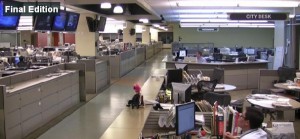The Associated Press wraps up the debate over public and non-profit funding for newspapers, concluding that the economics could work for a few large players but not for most metro dailies. The New York Times would need an endowment of about $5 billion to sustain its current newsgathering operation, for example. The more promising and popular approach is a targeted for-profit model like MinnPost.com and investigative journalism foundry GlobalPost.
The latter example is particularly interesting because GlobalPost was founded as a nonprofit but switched to a for-profit model after potential donors demanded too much accountability. The venture later raised $8 million from individual investors.
Steven Coll, former managing editor of the Washington Post and now president of the New America Foundation think tank says some big paper is going to go the endowment route eventually and “is going to have an advantage.” However, the piece also points out that the St. Petersburg Times, which is owned by the nonprofit Poynter Institute, has had to lay off 30% of its staff, just like everybody else.
”Why a once-profitable industry suddenly seems as outmoded as America’s automakers is a tale that involves arrogance, mistakes, eroding trust and the rise of a digital world in which newspapers feel compelled to give away their content,” writes the Washington Post’s Howard Kurtz, in a tight summary of the last 50,000 or so words posted to this blog.
Kurtz uses last week’s closing of the Rocky Mountain News as a jumping-off point to tap into the industry’s angst over What Went Wrong. The story sheds little new light on the problem or the solutions but sums up the issues and possible solutions so much more succinctly than self-important opuses like the one last week in the New Republic. And it has a striking quote from Joshua Micah Marshall, whose Talking Points Memo (TPM) is often held up as an example of the focused model that may replace sprawling daily newsrooms. “If all the big papers disappeared right now and we replaced them with 50 TPMs, it wouldn’t come close to doing the job,” says Marshall, who employs just six people. “But we’re in a broader transformation where models like ours and others are going to evolve that can fill the void.”
TechDirt’s Mike Masnick rants about what he sees as the absurdity of newspapers’ plans to charge for content. He’s especially put out that Newsday, which has poor audience affinity to begin with, should lead the way. Charging for access to news websites isn’t just dumb, it’s arrogant, he says. Newspapers “always made their money selling the attention of their community to advertisers. But when they treat that community with contempt at the very same time that the community has many other options, it should be no surprise that the community goes away.” Masnick sees no chance for pay walls to work out. If anything, it will only accelerate the emergence of free alternatives.
Layoff Log
- Two large upstate New York publishers are taking the ax to their payrolls. The Albany Times Union needs to cut its costs by 20% in order to stay viable, said Publisher George Hearst III. Employing blunt language, Hearst said the cuts were needed or the paper would be at risk. “The very survival of our enterprise hinges upon cost-cutting that must include the departures of people who are part of this company,” he said. While no numbers were mentioned, the paper’s total employment of 453 indicates a forthcoming reduction of about 90 jobs. Hearst called the advertising slowdown unprecedented. “I’ve been here two decades and I’ve never seen anything like this,” he said.
- The Buffalo News plans to lay off 52 employees if union negotiations fail to achieve a breakthrough, says WKBW-TV. The station got hold of a memo publisher Stan Lipsey that lists 33 layoffs in circulation, eight each in editorial and classified advertising, two in accounting and one in marketing. The paper also extended a buyout offer that so far has had only lukewarm acceptance. While Guild negotiations continue, the paper has taken other cost-cutting measures, including a wage freeze for non-union employees and closing the Niagara County bureau. The newsstand price was also increased to 75 cents.
- The Columbus Dispatch will lay off 45 people by April 3, citing an advertising slowdown. “We avoided staff reductions as long as possible long after many other news organizations took such action,” Publisher John Wolfe said, adding that readership is holding up pretty well but advertising is way down.
- The Sacramento Bee will lay off 25 to 27 employees, but only if the Newspaper Guild agrees to a set of cost reductions that include pay cuts of up to 6 percent, limitations on vacation time and other sacrifices. If the union doesn’t agree, 11 additional newsroom jobs could be cut. The union represents 268 of the Bee’s 1,126 full- and part-time workers.
- The Wilmington (N.C.) Star News says it will outsource the printing of the newspaper to a company that has not yet been named. Nearly 40 full-time workers in the mail room and press room could be laid off as a result.
- The Bellingham (Wash.) Heraldis cutting 10 staff positions and reducing remaining workers’ salaries by up to 5%. A similar tack is being taken by the Myrtle Beach Sun News, which will cut 20 jobs, reduce the length of the work week and cut pay for all salaried employees.
Miscellany
The Salt Lake Tribune has so far managed to avoid layoffs, but its decision to cut a half page of op-ed material nevertheless drew cries of outrage from readers. Columnist Vern Anderson asks readers to keep it all in perspective. Circulation has held steady, but the situation in the industry is “somewhere between grim and dire.” Everyone is cutting back, he says.
Last Friday’s final edition of the Rocky Mountain News ”sold like wildfire,” according to an article in India’s Sify News. “Some buyers who succeeded in getting a copy wasted no time reselling them on eBay. Multiple copies of the paper were posted to the online auction house, with prices ranging from a penny to $14.99.”
And Finally…
 Former San Franciso Examiner Editor Phil Bronstein identifies the one person who deserves the blame for the newspaper industry’s troubles: It’s him. Bronstein contributes a wry, Web-savvy and ultimately engaging insider’s perspective on the sequence of events that began in 1992 when he saw his first Web page and culminated last week with a colleague slumped in his chair muttering, “I thought I had this job till I retired.” Having read what sometimes feels like hundreds of angry screeds by resentful editors over the last two years, we were refreshed to find a refugee who’s managed to keep some perspective on it all and even find some humor. We guess we live on what Bronstein calls the “scold side” of the business.
Former San Franciso Examiner Editor Phil Bronstein identifies the one person who deserves the blame for the newspaper industry’s troubles: It’s him. Bronstein contributes a wry, Web-savvy and ultimately engaging insider’s perspective on the sequence of events that began in 1992 when he saw his first Web page and culminated last week with a colleague slumped in his chair muttering, “I thought I had this job till I retired.” Having read what sometimes feels like hundreds of angry screeds by resentful editors over the last two years, we were refreshed to find a refugee who’s managed to keep some perspective on it all and even find some humor. We guess we live on what Bronstein calls the “scold side” of the business.
Comments
This entry was posted on Tuesday, March 3rd, 2009 at 9:00 pm and is filed under Facebook, Fake News, Hyper-local, Solutions. You can follow any responses to this entry through the RSS 2.0 feed. Both comments and pings are currently closed.




The Salt Lake Tribune is the “non-Momon/independent” paper in the city. It leads the Mormon owned Deseret News about 2-1 in circulation. The Kearns family lost the Trib to Dean Singleton’s organization after the family sold it..with option to buy it back at a later date. (family squabble..some of the family wanted their money out of the paper.) The Trib has a unique place in the city…it offers balance to the heavy hand of control exerted by the Mormon church.
The Mormon owned Deseret News went to a.m. distrubution to compete with the Trib.(was afternoon paper)..but didn’t help. The Deseret News does have some readers who will never read the Trib, because they want to read their Mormon owned paper.
So, I think a religous divide will help Salt Lake’s two papers.
The two papers operate under a joint operating agreement. (Newspaper AgencyCorp.).
(They moved into a new modern building/new presses. )